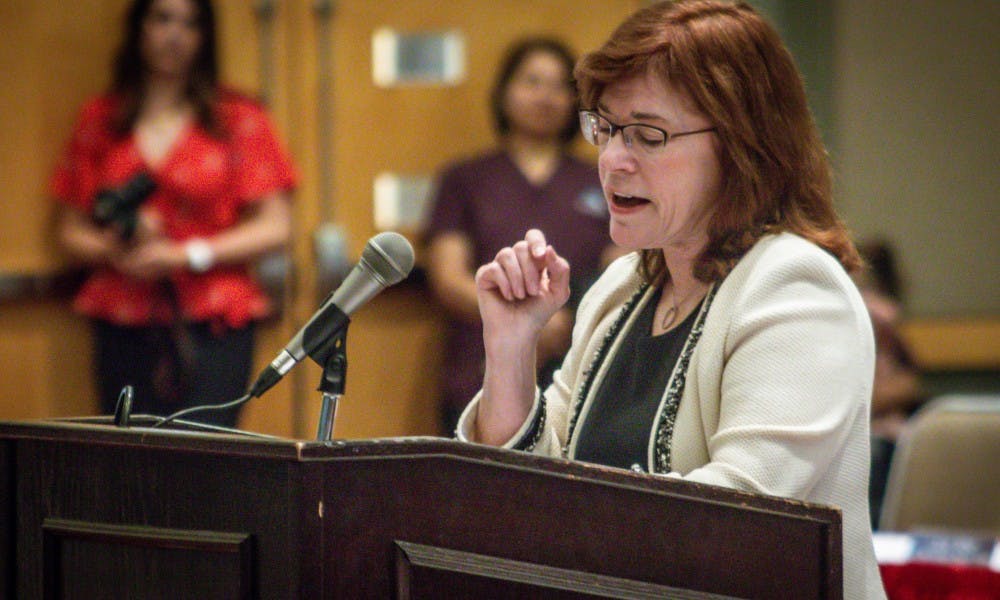The University of New Mexico is having its Budget Summit — again.
The special meeting of the UNM Board of Regents begins at 9 a.m. in the Student Union Building. It’s the second attempt to make decisions for the University’s $2.9 billion budget — including Health Sciences Center, Main Campus and its auxiliary budgets, which includes athletics.
The proposed budget will have to address a steep decline in enrollment, nationally low faculty compensation and the UNM Department of Athletics continued deficit management.
UNM is considering different scenarios to fund a state-mandated pay increase for employees — some of those proposals have included raising tuition.
UNM postponed approving the budgets for Main Campus and Health Sciences Center at their scheduled Budget Summit on Tuesday, April 9. The delay stemmed from a letter from the Higher Education Department Cabinet Secretary Kate O’Neill mandating postsecondary schools provide a 4 percent compensation increase — which UNM’s draft proposals did not meet.
Some scenarios for paying for the pay bump showed base tuition increases ranging from 2 percent to 6 percent.
Nicole Dopson, director of financial operations for Academic Affairs, is a member of the Budget Leadership Team. In a previous interview with the Daily Lobo, she said the tuition increase proposals were not final.
She said other options include examining out-of-state tuition increases, or no increases, but cuts to programs and staff instead.
The Daily Lobo previously reported on BLT-recommended 2020 increases to fees and upper-division courses. According to the proposal with premium increases and technology fee:
- Currently, students taking 15 credit hours of only lower division classes pay $3,661 between tuition and student fees. The 2020 proposal requires students pay an additional $82 per semester.
- A student taking 15 credit hours of all upper division classes pays $4,036 currently. Under the proposal, they would pay an additional $232 per semester.
- Graduate students taking 12 credit hours currently pay $4,471 a semester. Under the proposed changes, they would pay an additional $188 per semester.
Any tuition increases would be in addition to the above recommendations.
University President Garnett Stokes said the total cost of a 4 percent compensation will cost UNM $29.9 million. She said that number includes the pay bump — 4 percent of salaries — but also what the University pays in fringe benefits, such as retirement and health care.
Get content from The Daily Lobo delivered to your inbox
The BLT had only proposed a 2 percent increase for UNM employees in their 2020 draft budget.
The New Mexico HED received $23.2 million to disperse between all two and four-year institutions, and other specialized education institutes (New Mexico military institute, and schools for the blind and deaf), to provide for the salary increase.
BLT’s recommendation to have a smaller raise came from an interpretation of a two-word phrase in the massive state appropriations bill — a phrase that Gov. Michelle Lujan Grisham line-item vetoed.
The language vetoed was “average salary.” The Daily Lobo asked Dopson why the University interpreted that language to give a 2 percent pay bump rather than the full 4 percent increase.
Dopson said the BLT made their recommendation because the state Instruction and General fund (I&G) appropriation — the piggy bank for the academic side of UNM — only funded half of the employees with the increase. She said UNM would give a smaller, but equal, pay increase to its employees.
“Basically, we’re going to equitably fund the 2 percent (increase) across the board for the amount they allocated us, and it’s been our practice in prior years,” Dopson said.
I&G is made up of two sources: tuition revenue and state appropriations. According to Stokes, only half of UNM’s employees are paid by I&G — which she said requires UNM to find additional means of funding.
The governor's veto, and the letter from her cabinet secretary, made it clear the state expects UNM to provide a 4 percent increase.
State Sen. Jacob Candelaria, D-Albuquerque, told the Daily Lobo that the governor’s line-item strikethrough makes raises clearer, but the appropriation does not reflect what the University would have to pay.
“I think it’s good public policy to give all employees a four percent raise, the reality though, is the budget did not contemplate that,” Candelaria said. “And now, the University is going to have to try and figure out how to compensate.”
The University said it’s options to secure the funding are limited.
Candelaria said it could include getting supplemental appropriations from the legislature, and, or raising tuition.
All financial appropriations originate in the House side of the Legislature.
Although a staff member confirmed that Daily Lobo messages were delivered, the House Appropriations and Finance Chair, Patricia Lundstrom, D-Gallup, did not respond for comment before publication.
Senate Finance Committee Chair John Arthur Smith, D-Deming, said higher education funding was not the primary focus of the session, despite the Roundhouse being flush with cash.
“Quite frankly most of the session was spent trying to solve the K-12 problem,” Smith said. “So that’s where most of the attention went, and scratching dollars for the I&G was difficult.”
Smith said the legislature had tried to negotiate a 4 percent increase for the I&G, but the result was 3.5 percent.
“I acknowledge the fact they were somewhat short-changed,” Smith said.
Smith said he was concerned that House Bill 2 was not going to provide fully for the University.
“I think we knew all along we weren’t going to reach it with what we had in the budget,” Smith said.
Justin Garcia contributed to the reporting of this story.
Danielle Prokop is a senior reporter for the Daily Lobo. She can be contacted at news@dailylobo.com and Twitter and @ProkopDani.






